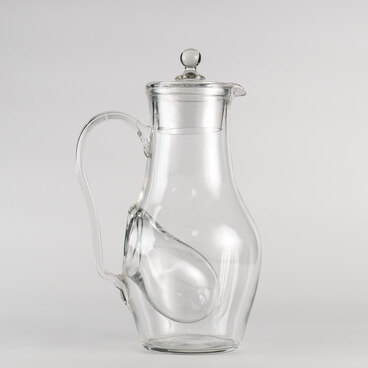A pitcher is one of the oldest types of vessels which is designed to store and serve drinks (water, juice, or wine) and has a pronounced neck and handle. The first glass pitchers were made long before the Common Era. Pitchers can have various shapes, including round, cone-shaped, ovoid, and cylindric. Usually, they have a flat bottom, sometimes — a short stem.
The pitcher from a water set was made in the style typical of the 1950s. During this period, the products of the Dyatkovo Crystal Factory were characterized by a festive, lavish, and elaborate design. This pitcher was produced of two-layer glass — colorless and cobalt. Depending on the mutual arrangement of the layers, the colored glass can be either above or below the colorless layer (the so-called “over-color” and “under-color”).
The deep blue color was achieved with cobalt. Cobalt compounds are used as a colorant in the ionic coloring technique. It is based on the presence of positive ions of certain metals in the glass. There is a positive correlation between the content of cobalt oxide in glass and its thickness and color density. Cobalt glass is more often used for creating overlay glass products. Dark blue glass has been found in the ruins of Troy and Pompeii, it was known in Alexandria, Byzantium, Greece, and Rome, and still enjoys well-earned popularity all around the world.
The floral motif of the deep-cut pattern is one of the most popular trends that can be observed throughout the entire history of the Dyatkovo Crystal Factory. Deep cutting is a labor-intensive process that requires a special machine. In Russian, this process of decorating crystal items is also known as diamond-shaped cutting. The most popular type of facet is cut using a disc at a 45º angle and has V-shaped cuts, which cross to form certain images. Initially, the image looks dull and dim. The distinctive gloss is achieved by polishing the crystal facets with hydrofluoric acid.
Although designed for everyday use, this pitcher is very colorful and festive. The water set includes a pitcher and two glasses.
The pitcher from a water set was made in the style typical of the 1950s. During this period, the products of the Dyatkovo Crystal Factory were characterized by a festive, lavish, and elaborate design. This pitcher was produced of two-layer glass — colorless and cobalt. Depending on the mutual arrangement of the layers, the colored glass can be either above or below the colorless layer (the so-called “over-color” and “under-color”).
The deep blue color was achieved with cobalt. Cobalt compounds are used as a colorant in the ionic coloring technique. It is based on the presence of positive ions of certain metals in the glass. There is a positive correlation between the content of cobalt oxide in glass and its thickness and color density. Cobalt glass is more often used for creating overlay glass products. Dark blue glass has been found in the ruins of Troy and Pompeii, it was known in Alexandria, Byzantium, Greece, and Rome, and still enjoys well-earned popularity all around the world.
The floral motif of the deep-cut pattern is one of the most popular trends that can be observed throughout the entire history of the Dyatkovo Crystal Factory. Deep cutting is a labor-intensive process that requires a special machine. In Russian, this process of decorating crystal items is also known as diamond-shaped cutting. The most popular type of facet is cut using a disc at a 45º angle and has V-shaped cuts, which cross to form certain images. Initially, the image looks dull and dim. The distinctive gloss is achieved by polishing the crystal facets with hydrofluoric acid.
Although designed for everyday use, this pitcher is very colorful and festive. The water set includes a pitcher and two glasses.


